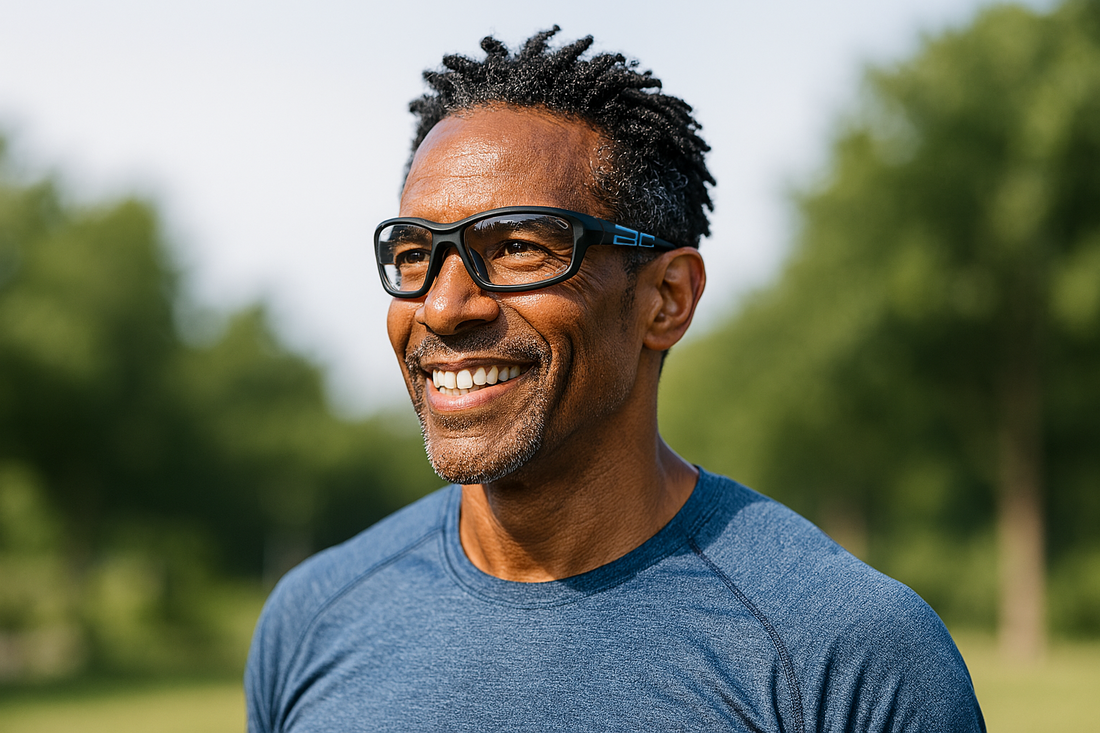
How Progressive Lenses Improve Vision in Sports
Split-second focus shifts can make or break a play. If you rely on prescription eyewear, progressive lenses can give you the all-distance clarity you need to read a smartwatch, track a ball at speed, and scan the field without changing glasses. That seamless focus is a quiet advantage in training and competition 🏃♂️.
Why they matter on the field, court, and course
Progressive lenses combine distance, intermediate, and near powers in one pair. The upper zone supports clear distance vision for field awareness. The middle zone covers intermediate tasks like looking down a fairway marker, a bike computer, or a teammate at mid-range. The lower zone handles up-close needs such as reading a playbook, tying laces, or checking lap splits.
In fast sports, your eyes transition constantly. Progressives allow smooth shifts between zones with minimal image jump, so you can react quicker and keep your attention where it matters 🎯.
Key benefits for athletes
- Seamless focus from near to far, reducing the need to swap eyewear mid-session.
- Optimized peripheral clarity with modern designs that widen the usable field of view.
- Better depth perception by maintaining binocular balance across zones.
- Fewer distractions from glare when paired with quality anti-reflective coatings.
- Convenience on the go: see the scoreboard, the route, and your data with one pair.
Fit and frame choices for game-day comfort
Start with a stable fit. Look for lightweight, sport-ready frames with adjustable nose pads and grippy temples to prevent slipping when you sweat. Helmet and cap compatibility matters too; try frames with low-profile temples that slide easily under headgear 🕶️.
Wraparound frames can improve coverage and wind protection. Many labs can tailor progressive optics to the frame’s curvature using wrap compensation, which helps keep edges clear. Choose durable, impact-resistant lens materials like polycarbonate or Trivex for safety without extra weight.
For outdoor play, consider interchangeable or sport-tuned tints. Brown, copper, and rose tints can boost contrast on grass, clay, snow, and road surfaces. Polarized lenses cut glare off water and pavement, helpful for fishing, rowing, and road cycling.
Lens tech that elevates performance
Digital free-form progressives are crafted on the back surface of the lens for sharper optics and wider corridors. Your measurements matter: pupillary distance, fitting height, pantoscopic tilt, vertex distance, and frame wrap help the lab position every zone where your eyes naturally look.
Ask for a sport-optimized corridor. Runners and field athletes often prefer a taller distance zone for horizon scanning. Cyclists may want a slightly boosted intermediate area for quick glances at a bike computer. Golfers benefit from stable distance with smooth intermediate for setup, plus near for scorecards.
Coatings and treatments can be the finishing touch. Anti-reflective layers improve clarity under stadium lights. Hydrophobic and oleophobic coatings repel sweat and dirt. Anti-fog treatments help during high-exertion intervals or mask use. Scratch-resistant layers protect your investment so you stay focused on performance 🥇.
Training tips to adapt quickly
- Break them in gradually: 1 to 2 hours indoors, then easy practice drills before full-intensity sessions.
- Lead with small head movements to find the crispest section, then refine with your eyes.
- Mark your visual routines: where to glance for your watch, scoreboard, or lines on the field.
- Keep lenses clean; smudges amplify blur in any lens design.
When a different setup might win
Some athletes benefit from a dual setup: contact lenses for distance paired with sport sunglasses, or a dedicated single-vision pair for a specific position or event. If your sport is extremely distance-focused, a single-vision sport lens can provide the widest, most uniform field. Many competitors still choose progressives for daily training and travel, then switch to a task-specific pair on race day.
Pro fitting makes the difference
A precise fitting ensures your visual sweet spots align with your posture and frame geometry. Share details about your sport, typical head position, and the data you check most. With the right frames, lens design, and coatings, progressive lenses can become a trusted part of your kit, helping you move with confidence, clarity, and control.
FAQs.
How do progressive lenses help in fast-paced sports?
They deliver smooth focus from near to far, so you can track action, read data, and scan the field without switching glasses.
What lens materials are best for athletic safety?
Polycarbonate or Trivex are light, impact-resistant, and ideal for active use.
Can I use wraparound frames with progressives?
Yes. With digital wrap compensation and proper measurements, progressives can perform well in curved frames.
Do tints and coatings really make a difference?
Anti-reflective, hydrophobic, and anti-fog layers enhance clarity, while contrast tints like brown or copper help define terrain.
Why does it take time to adapt to new progressives?
Your brain learns how to use each zone. A few short practice sessions usually smooth the transition.



